Mon Mar 30 2020 · 33 min read
Reforming Regional Representation in Armenia’s Parliamentary Elections

By Harout Manougian
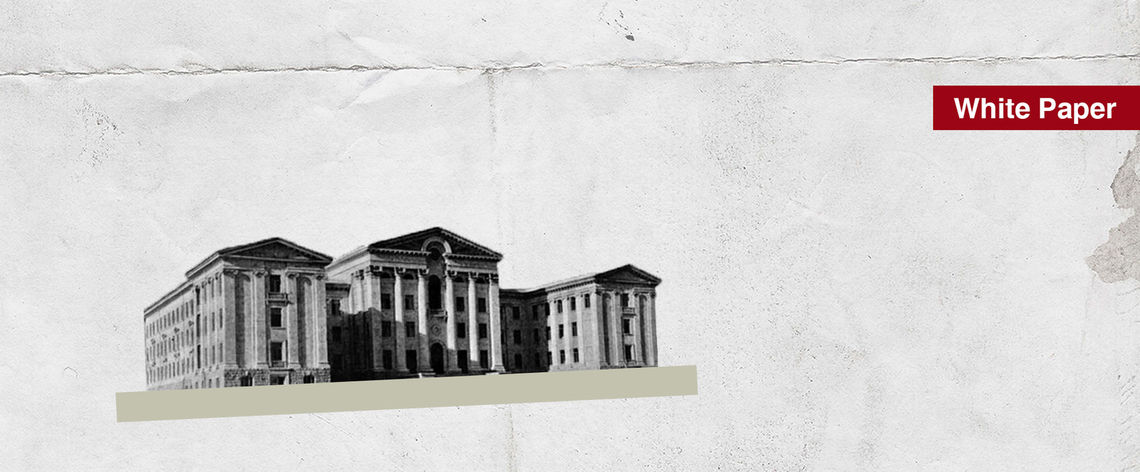
1. Executive Summary
This analysis assesses the performance of Armenia’s current electoral system in a number of areas, focusing on regional representation. It discusses the unsuccessful proposal to abandon district-based open lists in 2018 and introduces a new compromise between that proposal and the status quo.
It recommends holding Armenian parliamentary elections in three multi-member districts, specifically Yerevan, Northwest and Southeast, that would yield 32 to 36 MPs each, allocated proportionally to each political party depending on their performance in that district. Seats would be given to each party’s predetermined closed list specific to that district.
2.Introduction
2.1. Background
Upon independence in 1991, Armenia’s Parliament, called the Supreme Council at the time, consisted of representatives from 260 single-member geographic districts. In 1995, a new constitution was passed, the Parliament was renamed the National Assembly, and fresh parliamentary elections were held. Under the new system, there would be 150 geographic districts, whose representatives were elected using the first-past-the-post (single member plurality) system, and also 40 additional seats, awarded proportionally to the political parties based on their nationwide vote totals. Voters cast separate ballots for their district representative and their preferred party. The party affiliations of the elected district representatives had no bearing on the allocation of the proportional seats. This system is called mixed member majoritarian (MMM), or a parallel-mixed system, and was a common approach for successor states of the Soviet Union. Over the years, the share of proportional seats was consistently increased until the country adopted a fully proportional model beginning in 2017, as shown in Table 1. The details of the current system, which was used for the most recent elections in April 2017 and December 2018, are explained in the next section.
Table 1. History of majoritarian and proportional seat share in Armenia’s legislature
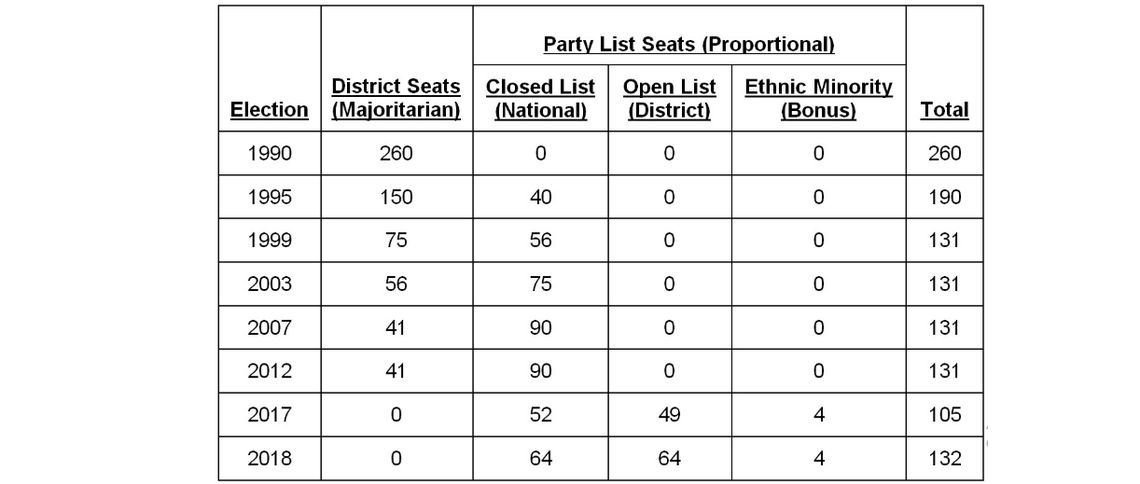
2.2. Scope
Armenia’s 2015 Constitution and 2016 Electoral Code include several aspects that distort the proportionality of parties represented in the National Assembly. These provisions include:
-
the requirement to meet a minimum electoral threshold (5% for parties, 7% for party alliances) to get any seats in parliament.[1]
-
the way reserved seats for ethnic minorities are allocated, which effectively become bonus seats to the largest party or parties.
-
a stable majority provision that assigns bonus seats to a party that receives between 50% and 54% of the seats in the National Assembly.
-
an effective opposition provision that assigns bonus seats to some smaller parties (but not those who failed to meet the electoral threshold), in the event the largest party receives more than two thirds of the seats in the National Assembly.
-
a runoff round that only the two largest parties can contest, in the event a governing coalition is not formed with a majority of the seats in the National Assembly.
Although these and other provisions are worth discussing, this analysis deals only with the issue of regional representation.
Similarly, this analysis uses the minimum number of 101 seats as the size of the National Assembly without assessing whether this number should be increased or (by constitutional amendment) decreased.
The changes recommended by this analysis are possible to implement by amending the Electoral Code, without the need to make changes to the existing Constitution.
2.3. Glossary
Closed list: The political party presents a rank-ordered list of candidates. If the party receives X number of seats, the top X names on their list are elected. Voters cannot indicate a preference for a candidate with a lower rank on the list.
ED: electoral district
Elector: a person who is eligible to vote (whether or not they have actually voted)
FPTP: First-Past-The-Post, sometimes also referred to as single member plurality (SMP), is the voting system in which each electoral district returns only one elected representative, who needs to obtain the highest number of votes but not necessarily a majority of votes cast.
MMM: Mixed Member Majoritarian, sometimes also referred to as a parallel-mixed system, an electoral system where some MPs are elected from FPTP districts and others from closed lists but the two components do not impact each other.
MMP: Mixed Member Proportional, an electoral system where MPs elected from FPTP districts are complemented by additional seats off a closed list, in order to balance the overall proportionality of parties’ seats to their vote share
MP: Member of Parliament
Open list: The political party’s list of candidates has no predetermined rank order. If the party receives X number of seats, the top X candidates who receive the most individual votes are elected.
SNTV: Single Non-Transferable Vote, an electoral system that allows a voter to choose only one candidate from a list, even if more than one may be elected.
STV: Single Transferable Vote, an electoral system where more than one representative is elected from each electoral district. Voters get to rank the candidates in their order of preference.
3. The Current System
The 2015 Constitution included the provision that “The National Assembly is elected by a proportional electoral system.”[2] The Constitution does not specify details about districts or open and closed party lists. Those details are left to the Electoral Code.
The Electoral Code implements proportional representation using a system that appears to be unique in the world. It combines a nationwide closed list component with a district-based open list component. Half of a party’s MPs are chosen from each component.
A political party (or alliance of political parties) presents a number of different lists when registering for the parliamentary election. The first is the nationwide list, which consists of two parts. Part I of the nationwide list (the “closed list”) is the rank order of all the candidates that that political party is putting forward for the election. The closed list must include a minimum of 80 candidates but no more than 300 candidates. For perspective, the April 2017 parliamentary election yielded a total of 105 MPs, from all political parties, to the National Assembly, while the 2018 parliamentary election resulted in a total of 132 elected MPs.[3] The closed list must also adhere to a gender quota for the candidates presented. For the 2017 and 2018 elections, each set of four candidates on the list needed to include at least one candidate from each gender. That is, at least one candidate among the top four must be a woman, two in the top eight, etc. The current Electoral Code already includes a provision to raise this quota to one in three candidates for elections held after January 1, 2021.[4] At least 70% of the candidates on the closed list must be members of the political party. The remaining 30% of the candidates could either be members of another political party or independents.
Part II of the nationwide list (the “ethnic minority lists”) is used to designate candidate(s) for the reserved seats for Armenia’s four largest ethnic minorities: Yazidis, Russians, Assyrians and Kurds. These candidates can also be ranked on the main Part I closed list but do not need to be. A party can list up to four candidates, in rank order, for each of the four designated ethnic minority seats. Although the ethnic minority lists are technically part of the nationwide closed list, this analysis will use the term “closed list” to refer specifically to Part I of the nationwide list.
From the names on the closed list, the party also creates thirteen district-based open lists[5] for each of the thirteen electoral districts spelled out in the Electoral Code.[6] Each region of Armenia makes up its own electoral district, except for the regions of Vayots Dzor and Syunik, which are combined into one district. The capital city of Yerevan, which is not in any region (marz, in Armenian), is split into four electoral districts. The district numbers and their sizes are presented in Table 2 and Figure 1.
Table 2. Armenia’s 13 electoral districts
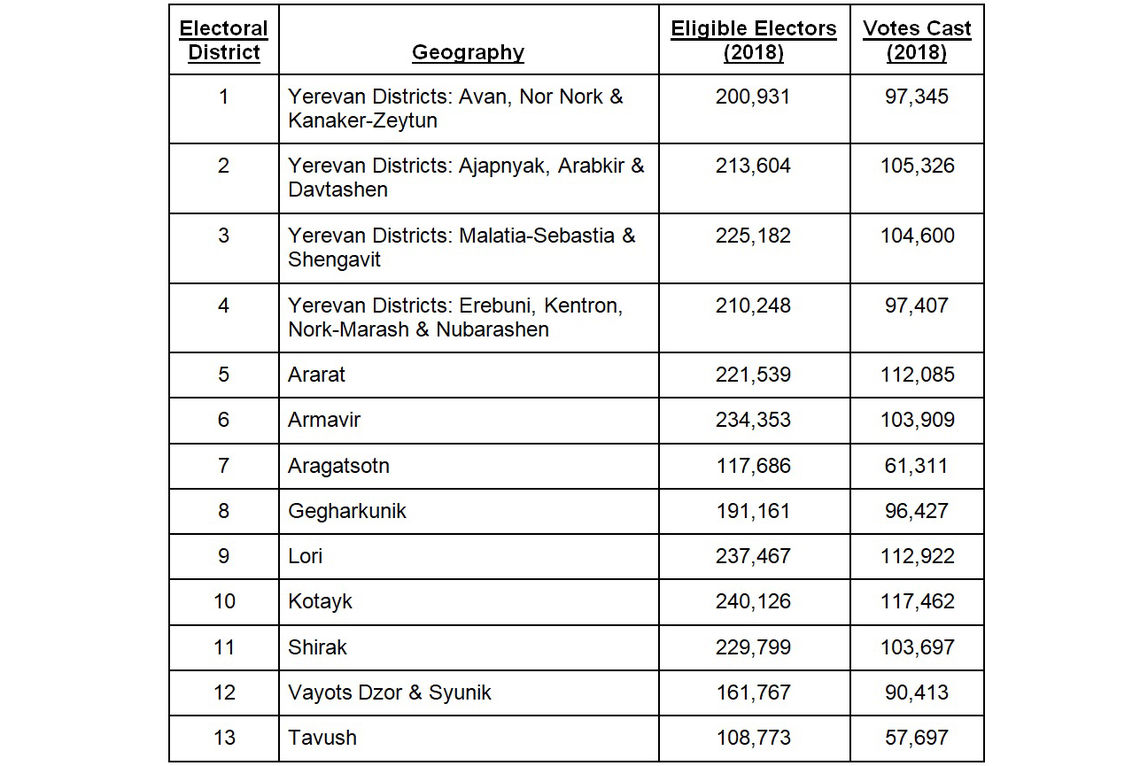
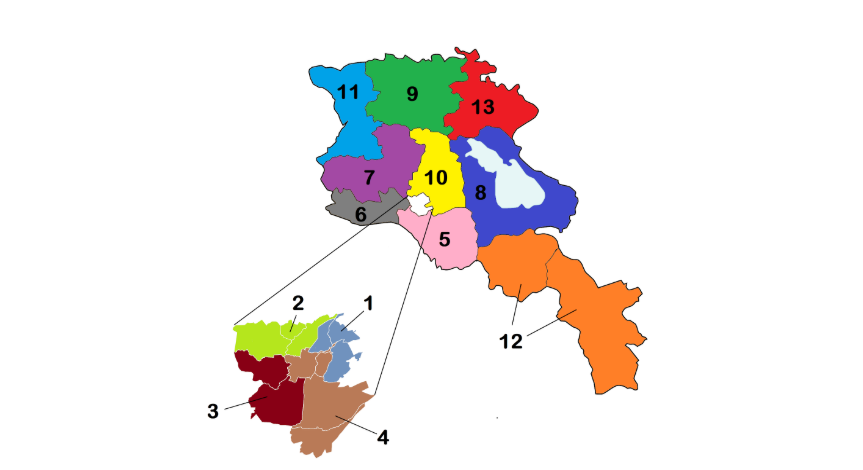
Figure 1. Map of Armenia’s 13 electoral districts
Though most of the electoral districts are comparable in size, with about 100,000 votes cast in the December 2018 parliamentary election, Tavush (ED13) and Aragatsotn (ED7) are outliers. The votes cast in the previous election is a better indicator for relative size since there are many names on the voter registry of supposed residents who have long since moved abroad or spend a significant part of the year working in another country, especially Russia.
The party’s thirteen district-based open lists are not in a rank order, they are printed on the ballot alphabetically by last name.[7] The maximum number of candidates on a party’s open list for each district is determined by the number of eligible electors on the voter registry divided by 15,000. Thus, a party can place up to seven names on its open list for Tavush (the smallest district) and up to 16 candidates on its open list for Kotayk (the largest district). A party must place a minimum number of five candidates on each district open list.[8] No candidate can be on the open list for more than one district. A gender quota of at least 30% applies to the party’s open list of candidates for each district.[9] For example, if a party nominates 11 candidates to the open list for Ararat, at least four must be women. However, there is no guarantee that women will be elected off the open list if voters do not choose them.
On Election Day, voters receive a separate ballot paper for each political party. They get to choose which party they wish to vote for by putting that ballot paper in an envelope and dropping the envelope into the ballot box. The other parties’ ballot papers are discarded by the voter in a wastepaper basket in the private voting booth. They are also able (but not obliged) to select one candidate from that party’s district-based open list for their area by marking a “v” (or checkmark) next to their name. The open list is printed on the reverse of the party’s ballot paper and is different in each electoral district. They cannot select one party but choose an individual candidate from another party; only the names of that party’s open list candidates are printed on that party’s ballot paper. If they select more than one candidate from the open list, their vote will still count toward the party but not toward any of the open list candidates. That is, the open list voting uses a system called Single Non-Transferable Vote (SNTV); the voter cannot indicate a second or third choice.
Notably, Armenia’s current electoral system does not actually reserve a set number of seats to each electoral district. This distribution is variable and will depend on how party support in each district plays out.
As an example, let us look at the results from the April 2017 parliamentary election. Four political parties[10] met the minimum threshold. The 9% of valid votes that were cast to the other five parties, which did not meet the minimum threshold, are discarded as if those voters never participated. The four parties are allocated their share of the initial 101 seats (before the reserved ethnic minority seats are factored in). Half of the party’s seats from this calculation will be assigned to candidates on the open list and half to the closed list. If the number is odd, the additional seat is assigned to the closed list. Table 3 breaks down how each party’s seat allocation is divided.
Table 3. Allocation of seats to political parties (April 2017 Election)

The math is just getting started. If we take the Yelk Alliance as an example, Table 3 shows that they are assigned four open list seats. One might initially think that these four seats are awarded to the four candidates from that party who received the most individual open list votes, but the system first tries to allocate the four seats proportionally (using a formula called the d’Hondt method) to the electoral districts in terms of their support for that political party. For the purposes of this example, it is sufficient to say that the four districts with the most votes for the Yelk Alliance received one seat each. Table 4 shows that they happened to be the four Yerevan districts (electoral districts 1 to 4).
Table 4. Top Yelk candidate in each of the 13 electoral districts (April 2017 Election)
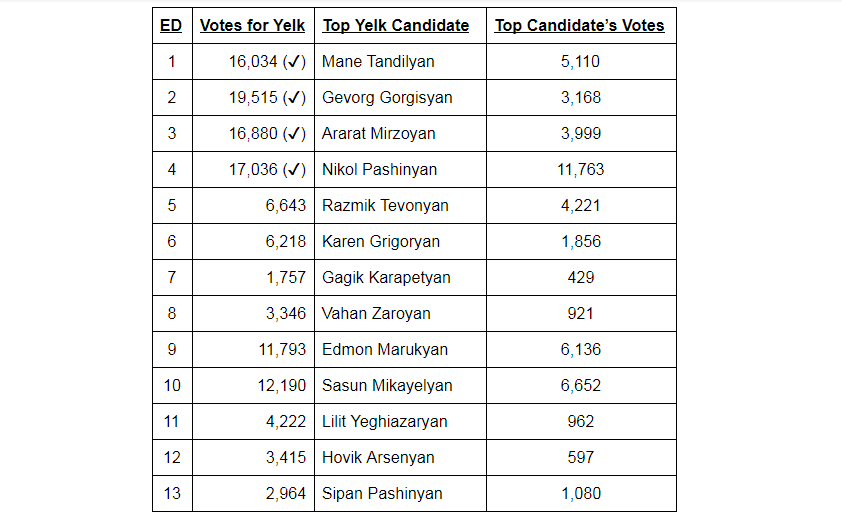
Thus, Gevorg Gorgisyan, Nikol Pashinyan, Ararat Mirzoyan and Mane Tandilyan were elected, in that order, to Yelk’s four open list seats, as they were the top Yelk candidate in the electoral districts that yielded the most votes to their political party. Note that, although Edmon Marukyan, Sasun Mikayelyan and Razmik Tevonyan received more individual votes than Gevorg Gorgisyan or Ararat Mirzoyan, they were not elected from the open list component because their party as a whole did not collect as many votes in the districts they ran in. There is no adjustment to the absolute number of votes, despite the fact that the electoral districts have varying numbers of eligible electors (see Table 2). Edmon Marukyan and Sasun Mikayelyan were subsequently awarded seats from the closed list, however.
The five closed list seats apportioned to the Yelk Alliance were awarded to the top candidates on the political party’s nationwide closed list, skipping over those candidates already elected through the open list. Table 5 demonstrates which candidates received these closed list seats.
Table 5. The national closed list of the Yelk Alliance (April 2017 Election)
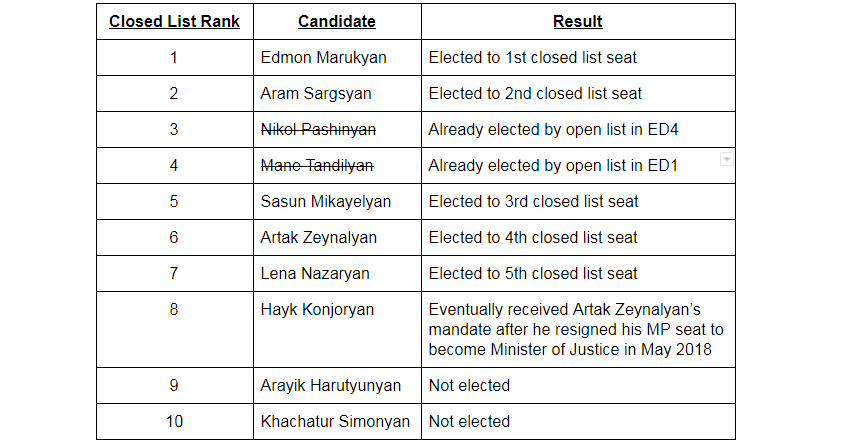
As Nikol Pashinyan and Mane Tandilyan were already elected to open list seats, the fourth and fifth closed list seats went to Artak Zeynalyan and Lena Nazaryan.
Later in the term, when Nikol Pashinyan was elected Prime Minister in May 2018, a number of MPs had to resign from their seat in order to take up new roles as cabinet ministers in the new government.[13] In such cases, the seat of an MP elected through the open list is transferred to the candidate from the same electoral district with the next highest individual vote total.
-
Nikol Pashinyan’s seat was handed to Alen Simonyan (ED4, 1776 votes).
-
Ararat Mirzoyan’s seat was handed to Hrachya Hakobyan (ED3, 3390 votes), skipping over Arayik Harutyunyan (ED3, 3904 votes) as he was also appointed to cabinet.
-
Mane Tandilyan’s seat was handed to Hovik Aghazaryan (ED1, 2620 votes).
The seat of an MP elected through the closed list is transferred to the next candidate on the closed list.
-
Artak Zeynalyan’s seat was handed to Hayk Konjoryan.
Notably, an MP who resigned their seat in order to become a cabinet minister does not get that seat back if they later resign from the cabinet post. For example, a month after becoming the Minister of Labor and Social Affairs in May 2018, Mane Tandilyan resigned from that position also (over a disagreement on pension reform). She only returned to the legislature after being re-elected in the December 2018 election.
4. Calls for Change
In the aftermath of the Velvet Revolution, when Nikol Pashinyan rose to become Prime Minister in May 2018, he declared that his first priority was to reform the Electoral Code and then immediately call an early election. He appointed a Special Commission on Electoral Reform to look into the issue. The Commission held a number of public consultations over that summer, eventually presenting their recommendations, which included the elimination of the open list component, in October 2018. Under their proposal, all seats would be allocated proportionally to parties based on the rank order of their nationwide closed list only; there would effectively be no more electoral districts. A number of justifications were given for this decision.
The first justification was that eliminating the SNTV component would make it harder for candidates to resort to vote bribery or voter intimidation through casting the secrecy of the vote into doubt. The main complaint from the April 2017 parliamentary election, both from domestic observers and the OSCE/ODIHR election observation mission, was “credible information about vote-buying, and pressure on civil servants and employees of private companies.”[14] It was believed that some campaigns handed out cash to supporters in return for their vote. As the vote is secret, different methods were used to (illegally) verify that the voter held up their end of the deal. Some older voters were accompanied by young volunteers who assisted them in filling out the ballot, an accommodation that is allowed under the current rules under the pretense of accessibility. Others were told to make a specific marking on the paper that a campaign member would supposedly look out for during the vote tallying process. Still others were deceived to believe that the pen in the voting booth had a hidden camera. It didn’t, but a legacy of state surveillance from the Soviet era was enough to psychologically coerce accomplices, who did not want to take a chance that it might be true, into compliance. Whereas a vote bribe was a positive incentive, voters could also be intimidated physically or threatened with dismissal by an employer, particularly in the public sector. Under this context, removing the need for a pen in the voting booth (necessary for the open list component only) would help to reassure voters that the secrecy of their ballot would be maintained, theoretically freeing them up to vote their conscience in the moment, even if they had promised otherwise to a campaign.
The district-based open lists were viewed as a scheme to farm out this vote bribing and surveillance function to local allies, the most successful of which would be rewarded with a seat in parliament. As each open list vote also automatically counted toward electing the top tier candidates on the closed list, the party elite could benefit from the shady tactics without needing to get their own hands dirty. That is, the inseparable link between the open list votes also counting toward the closed list helped authorities to tap into the personal and business networks of their local candidates, even if those voters were not enthusiastic supporters of the party’s senior leadership.
The second justification for eliminating the open lists was that it should help to raise the number of women elected to parliament.[15] While there were gender quotas for women to be included as candidates on both the closed list and the open list, the latter did not guarantee that the women candidates would be successful. The former did set a hard minimum. As Armenia is still a patriarchal society, the move toward a single nationwide closed list was pitched as a way to guarantee greater numbers of women in decision-making roles and eventually shifting cultural gender-based expectations. Table 6 does provide some empirical evidence that women were more likely to be elected from the closed list component, especially considering that, at the time of the proposal, the December 2018 election had not yet taken place.
Table 6. Gender breakdown of MPs elected by each electoral component
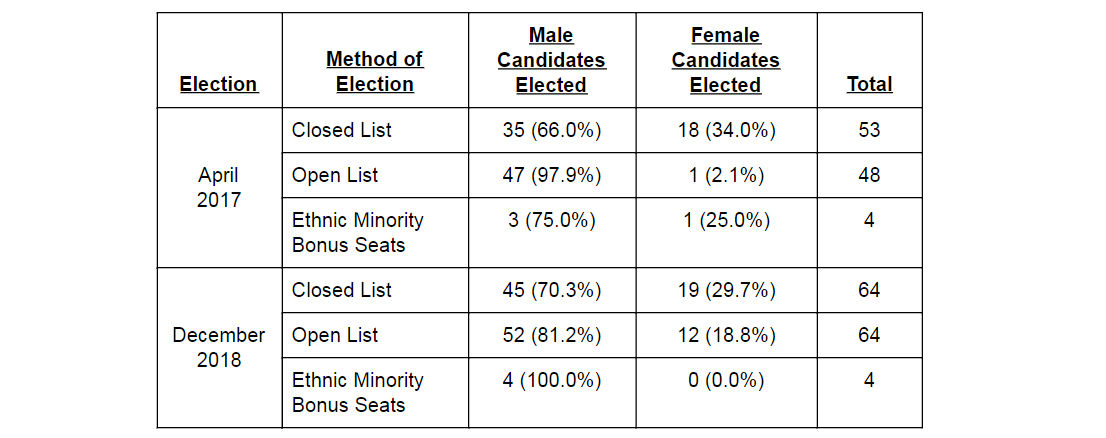
Although the proposal to move to a single nationwide closed list was put forward in October 2018, it failed to pass through the National Assembly because not enough Republican Party of Armenia MPs (who still dominated the legislature at that point) voted in favor of it.[16] Over a year later, it can be said that the consensus on this approach has dissolved over two issues. A single nationwide closed list:
-
would not adequately counterbalance the tendency for political parties to be dominated by Yerevan-based candidates and priorities.
-
could be seen to concentrate too much power in senior party figures, who could be allowed to dictate the rank order on the closed list according to their own personal preferences.
It is notable that the single nationwide closed list model is the approach that the Republic of Artsakh took upon moving from a mixed member majoritarian model to a fully proportional one with their latest 2017 Constitution. The first election that they will hold using this system is scheduled to take place on March 31, 2020.
5. Regional Representation as an Objective
There is no one perfect electoral system in the same way that there is no one perfect car. People buy cars for different reasons, based on their own priorities. They may be interested in seating capacity, headroom, fuel efficiency, performance, sticker price or any number of other factors. In this analysis of electoral systems, regional representation is considered an important priority, particularly in the context of ensuring that the population outside of Yerevan, which makes up two thirds of the electorate, is not marginalized.
Living standards and opportunities differ widely between Yerevan and the rest of the country. Even as economic development progresses, most advancement is concentrated in Yerevan such that the socio-economic gap only increases over time. One result has been the emptying out of rural areas and smaller cities as young people move to Yerevan for educational and career opportunities, or even become migrant workers in Russia in order to provide for their family. Due to a lack of infrastructure elsewhere, tourism revenue is also dominated by Yerevan-based businesses. The rest of the country can be viewed as a scenic backdrop for a day trip or as a store of natural resources, ripe for exploitation.
In the debate about mining, both sides vilify Yerevan-based groups, either as environmentalists threatening local potential jobs or as corporate elites threatening local environmental safety.
This tension between metropole and hinterland[17] is not unique to Armenia. Yet, ensuring that the needs of those living outside the capital are met, that they receive a fair share of economic development, is crucial to mitigating such sentiments from becoming an issue in the future. The best way to do so is for the people in decision-making positions to feel directly accountable to them. In this way, an electoral system can contribute to greater national unity by not overlooking regional representation.
6. Assessing the Status Quo
One may argue that the status quo system of combining open and closed lists, as complicated as it is, ensures adequate regional representation. But just how representative is it? Every citizen in Armenia is registered at an address. This registration address may not be where they currently live but it is where they are registered to vote. It could be their parents’ home, for example. Table 7 groups the registered addresses of the MPs elected during the last two elections. It shows that the current system does not do a particularly good job of ensuring that regional representation is proportional to the size of their electorates.
Table 7. Distortion in regional representation under the status quo
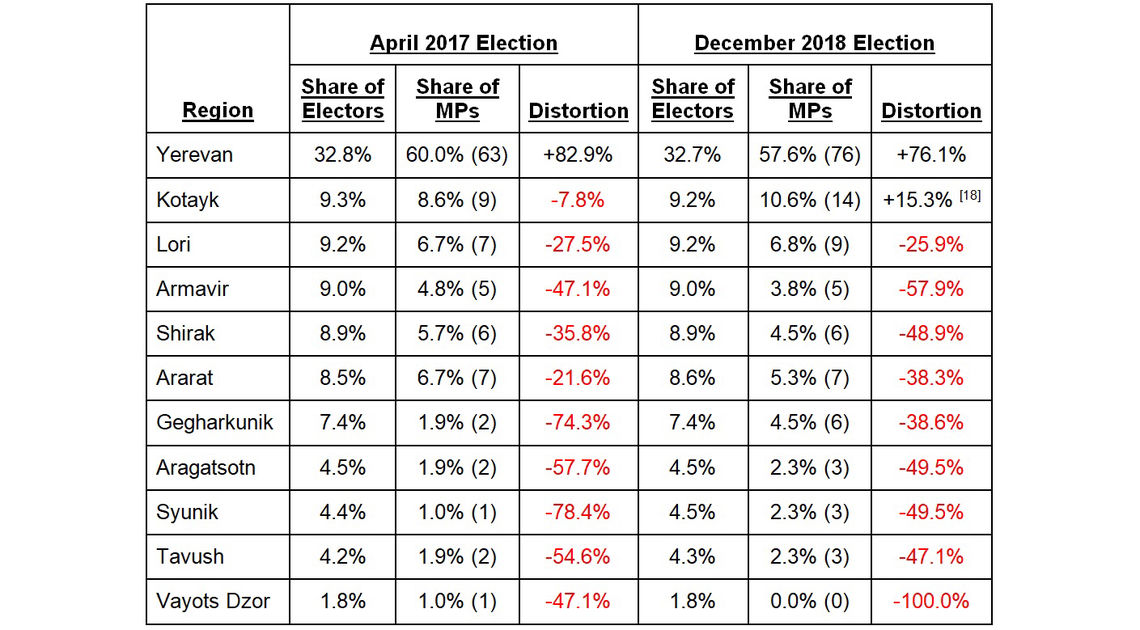
It should be noted that the status quo system never claims that the final seat allocation will be distributed proportionally to the regions by the size of their electorate. What it does provide for is that at least the open list seats (approximately half of the total) will be distributed to the electoral districts roughly in proportion to their absolute number of votes cast. Table 8 shows that it does do a better job at this in that the distortion is less polarized between Yerevan and non-Yerevan districts.
Table 8. Distortion in open list seat allocation under the status quo
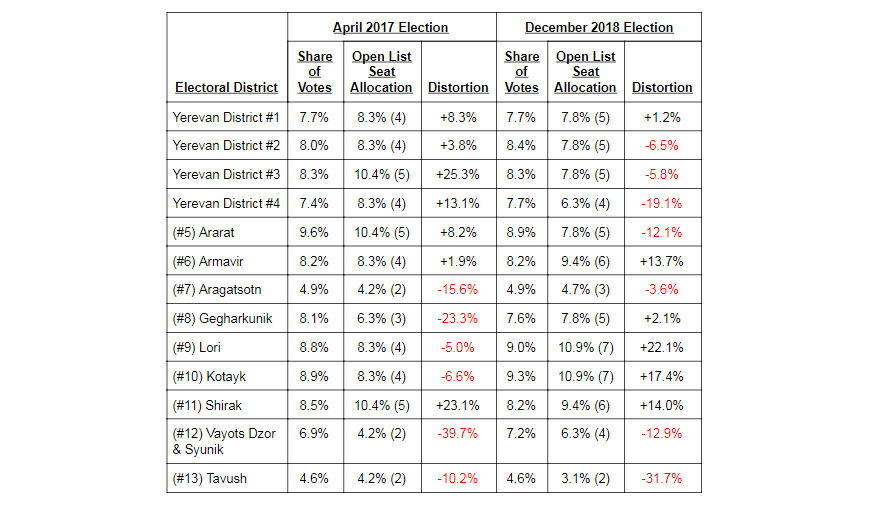
Thus, the skew in the status quo in favor of Yerevan-based candidates lies in the makeup of the closed list component and not the distribution of open list seats. Table 9 shows that approximately three quarters of MPs elected from the closed list are registered as residing in Yerevan, despite the capital making up only one third of the electorate.
Table 9. Breakdown of MPs’ registered address, by method of election
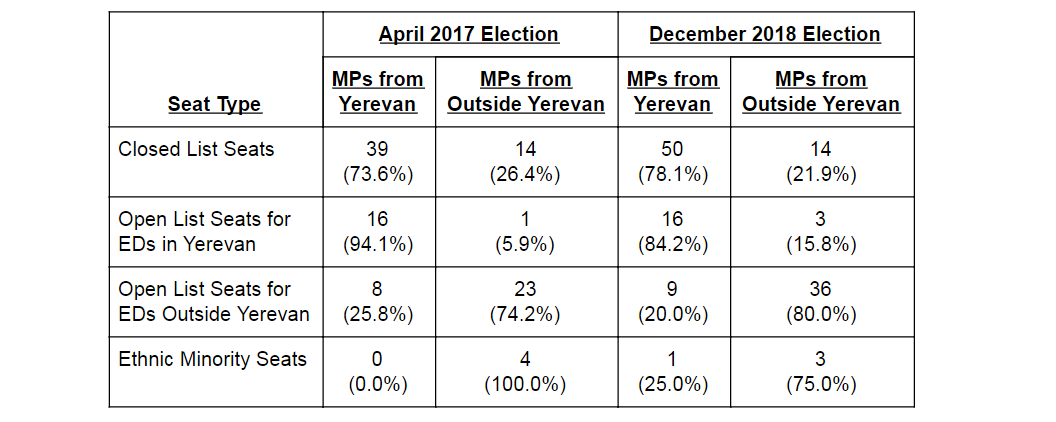
One could argue that it is natural for Yerevan residents to be over-represented as that is where most of the good universities and job opportunities are. Consequently, it can be surmised that Yerevan is where the most qualified candidates live. Table 9 shows further that, among MPs elected by the district-based open lists, not all have their address registered in the district they were elected by. A fifth to a quarter of the open list MPs elected by districts outside Yerevan reside in Yerevan themselves. In these cases, the MP, despite not currently living in the district (though 6 of the 9 in 2018 were born there), is legitimized by the local voters’ active choice. The current electoral system at least links these nine MPs to their constituents by the need to maintain their support if they want to seek re-election. For, if the voters from their district are not satisfied with their performance, they may choose someone else next time.
In the case of the 2018 parliamentary election, regional representation is improved somewhat by the fact that the total number of seats was increased from 105 to 132.[19] The smallest parliamentary caucus, the Bright Armenia Party, still received 18 seats. Even with the 11 additional seats they received due to the expansion of the legislature, their caucus still has zero MPs with their address registered in the five marzes of Aragatsotn, Kotayk, Gegharkunik, Ararat and Vayots Dzor.
If it is expected that a greater number of parties will surpass the electoral threshold in the future, the average caucus size will be smaller and the distortion will grow even greater in the smallest electoral districts, especially Tavush, Aragatsotn and Vayots Dzor-Syunik, as these electoral districts have fewer total voters than the others.
Besides regional representation, one could argue that an open list component decentralizes power from party bosses and allows candidates that were ranked lower on the closed list to rise to prominence. Certainly, the open list component was pivotal to the political careers of Ararat Mirzoyan and Gevorg Gorgisyan. Mirzoyan was ranked 19th on the Yelk Alliance closed list during the April 2017 parliamentary election. It was because he received the most votes in Yerevan’s third district that he was able to become one of Yelk’s nine MPs, and then move on to become Deputy Prime Minister and now Speaker of the National Assembly. Likewise, Gorgisyan, who was ranked 17th on Yelk’s 2017 closed list, secured a seat representing Yerevan’s second district and eventually became Secretary of the Bright Armenia Party.
Providing an incentive for individual candidates to hone their organizational skills and provide greater leadership depth for the party structure is certainly a welcome development. Yet, here again, the status quo provides a systematic advantage to candidates from Yerevan. The four Yerevan districts are geographically much more compact, which makes it easier (specifically, less expensive) to campaign there. It is a much more daunting task to travel from town to town in a region to build up a public profile than it is to get a single strategically-placed billboard on a major thoroughfare in a Yerevan suburb that a majority of constituents are likely to pass by every single day.
Finally, when individual candidates are responsible for their own personal campaign, the oversight function over campaign expenditures becomes much more daunting. Under current regulations, only parties submit financial reports. If an individual candidate wanted to print their own personal pamphlet, legally, they would be required to have the funds donated to the central campaign account, then ask the party’s permission to use that money to print their personal pamphlet for them to hand out. In practice, they are much more likely to use unofficial, unreported funds. There were 1287 open list candidates across the country during the 2018 election. Actively policing each of their campaigns for such violations is simply beyond the current capacity of the Oversight and Audit Service of the Central Electoral Commission, which has a staff of three people. Greater resources need to be allocated to financial oversight of election campaigns no matter which electoral system is used; however, closed lists would reduce the administrative burden on the responsible agency.
7. Assessing the Single National Closed List Alternative
If the status quo was replaced by the October 2018 recommendation to eliminate the district-based open lists, leaving only one national closed list per party, regional representation would only get worse.
The top names on a party’s closed list have tended to be Yerevan-centric for many of the reasons that have already been discussed. In fact, among the top 10 names on the three parliamentary parties’ closed lists for the December 2018 election, only two regions outside Yerevan have any representation:
-
The Bright Armenia Party has seven candidates from Yerevan and 3 from the Lori region
-
The Prosperous Armenia Party has seven candidates from Yerevan and 3 from the Kotayk region
-
The My Step Alliance [20] has eight candidates from Yerevan, one from Lori and one from Kotayk
Especially, if more parties make it into parliament and the caucus sizes get smaller, the regions of Tavush and Aragatsotn, with about 40% fewer voters than the others, are likely to have even less representation than they do now.
During discussions in 2018, it was suggested that quotas for each of the regions could be required from the parties’ closed lists. The Prosperous Armenia Party suggested [21] that at least one in every six candidates on the closed list would need to have been a resident outside of Yerevan for the past five years and continue to live there. Such an approach cannot realistically provide adequate regional representation, however. First of all, the quota is too low. A 23-member caucus could have as little as three MPs from outside Yerevan. Secondly, the regions that would be represented would tend to be the larger ones (Kotayk, Lori and Shirak) while the smaller districts would have even less representation than they do today. Thirdly, it is very difficult to precisely judge whether a candidate has met the residency requirement. Would their registered address be sufficient? They could keep their address registered at their parents’ home or at a second property to circumvent the spirit of the quota. Policing where MPs have slept most nights for the past five years is not something that anyone should need to expend effort on.
In short, at least as far as regional representation is concerned, a single nationwide closed list would be a step backward from what we already have today.
8. Three Closed List Districts
There is another way to retain the advantages of closed lists (namely removing the need for voters to mark the ballot and guaranteeing a minimum number of women MPs) while still ensuring that voters outside Yerevan are represented in proportion to their numbers.
As the city of Yerevan represents roughly a third of the electorate, the country could be divided into three electoral districts of comparable size. Table 10 shows how these three districts would be grouped, while Figure 2 represents the proposed electoral map.
Table 10. Three proposed multi-member electoral districts of comparable size
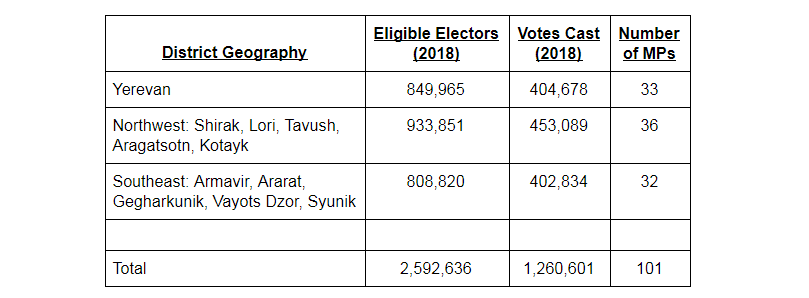
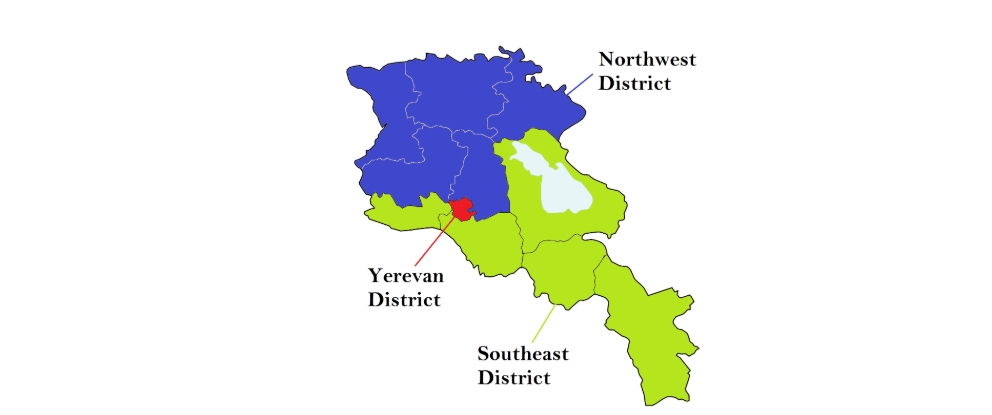
Figure 2. Map of the three proposed multi-member electoral districts
Note that, although the electorate in each of the three districts is comparable, they are not exactly equal. Therefore, the number of MPs reserved for each district needs to be slightly adjusted to maintain the proportionality between them. Whether this calculation is done using the number of eligible voters in each region or the actual number of votes cast in 2018, the result is the same: 33 seats for Yerevan, 36 seats for the Northwest, and 32 seats for the Southeast. It is recommended to base the calculation on the number of votes cast in the previous parliamentary election. Although doing so would lag more current figures, it provides an additional incentive for each individual to go out and vote, and encourage their friends and neighbors to do the same. It also helps to avoid any controversy as to the accuracy of the voter registry, especially regarding citizens who have moved abroad but are still registered as residents.
8.1. Why This Grouping?
In analyzing the geography and demographics of Armenia’s 10 regions and the capital city of Yerevan, it is clear that separate districts for each region would not be preferable as Vayots Dzor, Syunik, Aragatsotn and Tavush have a significantly smaller population than the others. This discrepancy, in addition to the low district magnitude (number of representatives from each district) would hamper the proportionality of the overall national results.
If the regions were grouped in twos and threes, the proportionality would improve with the higher district magnitude but it is just not possible to neatly group them into combined districts that are as close in size. Table 11 shows one possible grouping into six districts but you will notice that one district is significantly larger than the others. The 22 MPs allocated to the Shirak-Aragatsotn-Armavir district is based on the number of votes cast; if it were based on the number of eligible electors, it would rise to 23.
Table 11. Rejected six district model
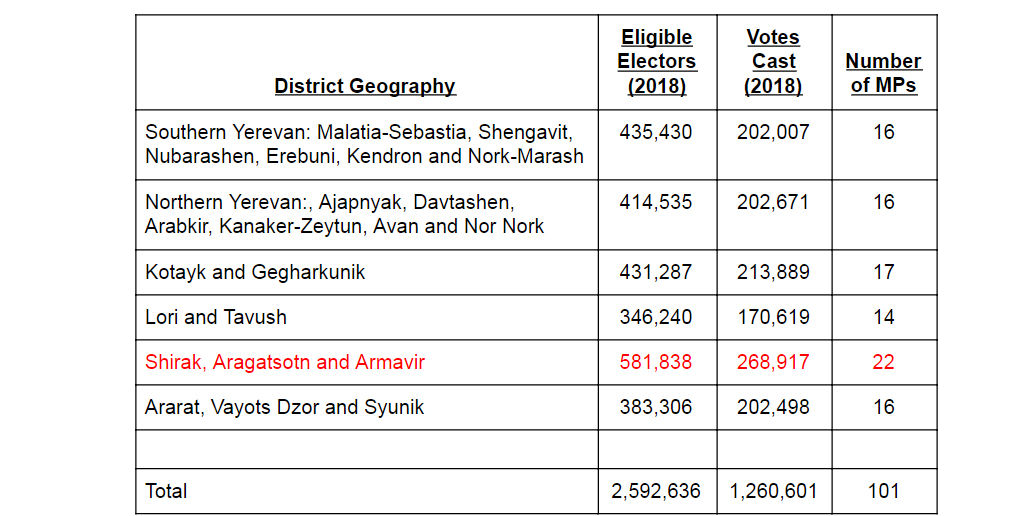
The districts are much more comparable in size if they are reduced to three. Even if a Northwest-Southeast principle is used, the grouping in Table 10 could be adjusted by swapping Armavir and Kotayk. Doing so would still keep two of the four regions that border Yerevan in each electoral district. However, the reason Kotayk was grouped with Aragatsotn and not Ararat is because it is separated from the region of Ararat by the Khosrov Forest State Reserve, with no highways connecting the two.
8.2. Why Closed List?
Although it could be possible to allow voters to select individual candidates (implement an open list) in their enlarged electoral district, doing so carries many disadvantages. The first is that such a process would still require the voter to mark the ballot, which has been associated with vote bribes and intimidation in Armenia’s recent past. The second disadvantage is that an open list cannot guarantee that a minimum number of women will be elected. The third disadvantage is that it greatly complicates the administration of the election. Allowing individual candidates to mount individual-centered campaigns makes oversight over campaign spending and donations much more difficult, as discussed previously. Restricting parties to only a closed list means less counting and fewer numbers to report from each polling station on election night; only the totals for each party would be needed, rather than those for each party’s several candidates. For political party representatives and independent observers that wish to verify official results, it would have been much easier to report only the totals for the 11 parties that ran in 2018. Instead, they had to record the individual tallies of each candidate at each polling station; Aragatsotn, with 69, had the least open list candidates, while Yerevan’s 2nd district, with 123, had the most.
A closed list would foster greater cooperation between candidates of the same party. As they aren’t competing against each other, individual candidates wouldn’t need to have their own personal scrutineer observing every polling station; one scrutineer from the party would effectively look after the interests of the whole group. This way, they could cover more ground together and raise trust in the final election results as more polls could be observed in-person by people they trust.
Lastly, in general, de-emphasizing individuals in favor of parties should refocus Armenian politics on larger policy approaches rather than personal and business contacts. A closed list should help to institutionalize a healthy, competitive multi-party democratic landscape in the country. Though not, in itself, sufficient for achieving such a goal, it is one tool in the toolkit that can contribute toward moving Armenian politics in that desired direction.
8.3. Aligning Incentives for Regional Representation
While it certainly doesn’t hurt, a representative does not necessarily need to be a woman to represent the interests of women, have a disability to represent the interests of people with disabilities, come from an ethnic minority to represent the interests of ethnic minorities, or live in a specific region to represent the interests of people from that region. It is important not to completely dismiss residents of Yerevan as incapable of addressing the concerns of citizens in smaller cities or rural areas.
Fortunately, the three-district closed list model contributes to legitimizing Yerevan-based candidates as representatives of citizens outside Yerevan. Table 9 showed that a quarter of open list seats for districts outside Yerevan were won by candidates whose address was registered in Yerevan at the time of the campaign. It is possible, though not necessary, that these candidates had roots or connections to the regions they were individually elected in. The important factor is that the citizens of that region were the ones who authorized them to act as their representative.
Under the three-district closed list model, it should not be a requirement for a candidate to necessarily be registered at an address in the electoral district they are running in. The system itself directly links the interests of the representatives with the people of their district; if they want to be re-elected, they should make sure their electorate is satisfied with their work and policy priorities. Otherwise, voters in the district they represent may opt for a different party in the next election and leave them without a seat. At the same time, it also incentivizes political parties to recruit and train cadres from those regions to include on their list of candidates.
It should be acknowledged that, even after moving to a three district model, MPs representing the non-Yerevan districts are still more likely to be anchored in regional capitals and larger cities than more rural areas.
8.4. Flattening the Party Hierarchy
The currently-used district-based open list component is applauded for decentralizing power within political parties, moving them away from institutions completely dominated by one individual. While the proposed three-district closed list model does take away the ability for voters to reward individuals they evaluate as more deserving, it still flattens party hierarchies.
The rank order of the currently-used national closed lists solidifies a very salient pecking order within the organization. If a candidate is ranked 120th, their inclusion on the list is more symbolic than actually offering an opportunity to be elected off the closed list. Although it would be possible for a party to establish internal procedures to give general members a greater say in the rank order of the closed list, in practice, the party leadership will very seldomly give up such an important responsibility with enthusiasm. Even among the top tier, candidates will be very conscious of who is ranked above them and who is below them.
By splitting the closed list into three, the actual ranking number of candidates is closer to the top in their respective district. For example, a candidate ranked 27th in a national list may be ranked 9th in one of the three districts. Psychologically, this dynamic should make them feel that they have a greater stake in the political party and that the effort they put in individually in their local area can contribute more directly to the possibility of them being elected.
Subject to a political party’s internal rules, separate closed lists can also facilitate greater grassroots involvement in the formation of the list. A party leader, who is already ranked 1st in their own district, may be more willing to delegate the responsibility of forming another district’s list to the party members from that area, if he or she feels it will result in a larger overall party caucus in parliament. Note that it is natural for a party’s leading figures to be interested and involved in the candidate nomination process but splitting the closed list into three creates one tool in a larger toolkit for broadening internal decision-making.
8.5. Natural Electoral Threshold and Gender Balance Considerations
One great advantage of districts with 32-36 members each is that they provide an acceptable natural electoral threshold. If a party receives about 3% of the votes in a given district, mathematically they should qualify for one seat there.[22] The approach is particularly friendly to upstart parties, who may not yet have built out a national-level network. Even if they have abysmal results in other districts, having a solid base in at least one could give them a foothold in parliament, establishing a foundation to build on. For example, the Bright Armenia Party eventually expanded nationally through coalition-building but started with a single seat in Vanadzor.
This analysis will not explore in detail what threshold is optimal. A nationwide electoral threshold could still be imposed if policymakers felt it was required. Districts with 32-36 members, however, at least open up the possibility that hard thresholds could be lifted while maintaining a natural threshold in the same general range that Armenian political parties are used to.
One important consideration is the effect of splitting a party’s closed list into three has on gender balance. Current legislation already foresees increasing the gender quota on the closed list to one in three after 2021. Note that gender quotas are inhibited by the remainder at the tail end of a party’s seat allocation. For example, if women are always ranked at the bottom of the triplet (3rd, 6th, 9th, etc.), a party that receives four or five seats (or seven or eight) will have a lower share of women MPs. By splitting the closed list into three, the chances for these remainder amounts increases, depressing women representation if the gender quota is kept the same. To compensate, the gender quota of each list would need to be increased, just to maintain the previously foreseen gender balance.
For the case of three districts, a gender quota of one in two (where each name on the list alternates between a male and a female) would not mean that 50% of a party’s MPs would be women, though that does become a possibility. If a party receives three seats each in the three districts, for a total of nine, a one in two gender quota could yield a caucus of three women and six men, a 33/67 split.
Currently, 31 of Armenia’s 132 MPs (23.5%) are women. A one in two gender quota on each of a party’s three district lists would not necessarily result in parity in the legislature. It would, however, provide the best opportunity to meet the commitment set by the United Nations in 1995 at the Fourth World Conference on Women, held in Beijing, for women to make up 30% of national legislatures.[23]
Though a parity quota is optimal for proportional gender representation, if a one in three gender quota is kept while transitioning to a three-district model, at the very least, an additional provision should be added so that a female candidate should be placed in the #1 or #2 positions in each district list (rather than consistently being relegated to #3) so that small parties will still have a reasonable ratio of elected MPs.
9. Other Possible Models
There are still other approaches to balancing regional representation that Armenia could consider. Each, however, includes drawbacks that do not make them ideal for the Armenian context.
9.1. FPTP: First-Past-The-Post (Single Member Plurality)
First-Past-the-Post (FPTP) is the common system used to elect members to parliament in the United Kingdom, Canada and much of the United States. The nation is divided into districts, each of which returns one representative to the lower house of the legislature. To be elected, a candidate just needs to get more votes than the others (a plurality) and not necessarily more than 50% of the votes cast (a majority). In some districts in the United States, a second runoff round may be held between the top two candidates if none receive at least 50% in the initial election.
This system severely distorts the proportionality of each party’s final seat count. Implementing it in Armenia would first require a constitutional amendment to remove the clause that requires elections to the National Assembly to be proportional.
It is also vulnerable to gerrymandering, where district borders are drawn so as to almost guarantee that a given party will win the district, based on the voting history of each neighborhood.
It took over 20 years for Armenia to move away from majoritarian single member districts. There would not be a political appetite to reintroduce them, despite their strength in ensuring direct regional representation.
9.2. STV: Single Transferable Vote
Another approach is called Single Transferable Vote (STV), which uses multi-member districts. Whereas the SNTV model Armenia currently uses for its open list component allows each member to choose only one individual candidate, STV allows each voter to indicate their first preference for an individual candidate, but also their second preference, third preference and so on. That way, if their first choice does not have enough votes to be competitive, their vote can be “transferred” to their next preference. It is used in Ireland, Malta, and for elections to Australia’s Senate.
Although the system does do a great job of rewarding the most popular candidates and can be implemented so as to ensure direct regional representation, it greatly compounds the complexity of the vote counting process. The sheer quantity of numbers that each polling station must report and the coordination required between them could delay results for several days. The counting process would take several rounds as the least popular candidates are eliminated in order until the final winners are decided.
Although Armenia could potentially consider moving to STV in the future, at the current time, the administrative burden would simply be too great.
9.3. MMP: Mixed Member Proportional
Another approach to balance proportionality with regional representation is called Mixed Member Proportional (MMP), which is used in Germany and New Zealand. It combines single member districts with a nationwide closed list similar to how Armenia held elections from 1995 to 2012. However, instead of the two components being independent of each other, the closed list is used to compensate for the disproportionality of the district-based results so that the final seat share of each party is in line with their nationwide results.
One major weakness of MMP is that it can be “hacked” by splitting a party into two, with each part focusing on winning either the district seats or the closed list total. Such a strategy could effectively collapse this electoral system into the same Mixed Member Majoritarian (MMM) system that Armenia used prior to 2015. To discourage parties from pursuing such a strategy, both Germany and New Zealand add additional “overhang” seats, increasing the size of the legislature, to offset the disproportionality the party-splitting strategy can cause.
Additionally, MMP systems, by reducing the number of MPs elected off the closed list, are not able to guarantee that a minimum number of women MPs will be elected.
10. Conclusions and Next Steps
The Parliamentary Working Group on Electoral Reform brings together elected MPs from all three parliamentary parties, along with representatives of state agencies and civil society organizations. The Armenian Government (executive branch) has set the end of 2020 as its target date for the preparation of a new draft of the Electoral Code to be introduced.
As shown by Table 12, a three-district closed list electoral system has a number of advantages over the status quo and it introduces them while strengthening regional representation rather than further diluting it, as a national closed list would do.
Table 12. Comparison of different proportional electoral systems

The three-district model should be included in public consultations and discussions with parliamentarians to gauge their receptiveness. Once the specifics of draft legislation are worked out, it can also be presented to the Venice Commission and OSCE/ODIHR for further feedback. Making this shift can reduce susceptibility to vote bribery and intimidation, increase the gender balance in parliament, ensure that regions outside Yerevan are appropriately represented at the decision making table, strengthen the institutionalization of political parties by widening their leadership circle and put Armenian democracy on a more solid footing for many elections to come.
11. Acknowledgements
The author wishes to thank Member of Parliament Hamazasp Danielyan and International Foundation for Electoral Systems staff Jerome Leyraud and Aghasi Yesayan for their guidance and feedback in exploring this topic.
The translation of the report from its original English version into Armenian was done by Fenya Yepremyan.
This project is funded by the UK Government's Conflict, Stability and Security Fund. The opinions expressed are those of the author and do not necessarily reflect the official position of the UK Government. There was no communication between the author and representatives of the UK Government on the content of the research.
--------------------------
1. This particular threshold has been in place since 1995.
2. 2015 Armenian Constitution, Article 89, Section 3
3. The number of MPs is not fixed but the Constitution sets a minimum of 101.
4. 2016 Armenian Electoral Code, Article 83, Section 4 and Article 144, Section 14
5. This open list component of the electoral system is referred to as ratingayin in Armenian.
6. 2016 Armenian Electoral Code, Article 78
7. 2016 Armenian Electoral Code, Article 83, Section 11
8. 2016 Armenian Electoral Code, Article 83, Section 9
9. 2016 Armenian Electoral Code, Article 83, Section 10
10. Two of them were actually party alliances but, for simplicity, this analysis will use “political party” to include alliances for the sake of the example.
11. The Tsarukyan Alliance was a joint ticket between the Prosperous Armenia Party, the Alliance Progressive Centrist Party and the Mission Party.
12. The Yelk Alliance was a joint ticket between the Bright Armenia Party, the Republic Party (a separate party from the Republican Party of Armenia) and the Civil Contract Party.
13. Unlike in Westminster parliamentary systems, the Armenian Constitution prohibits a Member of Parliament from being a Cabinet Minister at the same time.
14. OSCE/ODIHR Election Observation Mission Final Report, July 10, 2017: https://www.osce.org/odihr/328226?download=true
15. “Daniel Ioannisyan: The open list electoral system is an evil in all its manifestations and it will not continue,” 168.am, https://168.am/2018/07/06/978009.html
16. Amendments to the Electoral Code require affirmative votes from at least 60% of all MPs.
17. The metropolitan-hinterland thesis was formulated by Canadian historian Harold Innis.
18. Six of the 14 MPs elected in 2018 with their address registered in Kotayk live in Arinj and Abovyan, considered suburbs of Yerevan.
19. This increase in the total number of seats was due to the effective opposition clause in the 2016 Electoral Code, which seeks to dilute the largest party’s share of the legislature to no more than two thirds.
20. The My Step Alliance was a joint ticket between the Civil Contract Party and the Mission Party.
21. Video of MP Sergey Bagratyan presenting the policy proposal to the Parliamentary Working Group on Electoral Reform, July 6, 2018: https://www.youtube.com/watch?v=bz3xed91HGE&t=3m10s
22. Once in parliament, parties can join together into larger caucuses but that process is governed by the Parliamentary Rules of Procedure and not the Electoral Code.
23. Report of the Fourth World Conference of Women, September 4-15, 1995: https://www.un.org/womenwatch/daw/beijing/pdf/Beijing%20full%20report%20E.pdf#page=84
This project is funded by the UK Government's Conflict, Stability and Security Fund.
The opinions expressed are those of the authors' and do not necessarily reflect the official position of the UK Government.



